Dosing & Uses
Dosage Forms & Strengths
transdermal patch
- 1mg/24 hr
- 2mg/24 hr
- 3mg/24 hr
- 4mg/24 hr
- 6mg/24 hr
- 8mg/24 hr
Parkinson Disease
Initial: Apply 2 mg/24 hr transdermal patch qDay for early-stage disease or 4 mg/24 hr for advanced-stage disease
May be increased as needed by increments of 2 mg/24 hr at weekly intervals
Not to exceed 6 mg/24 hr patch qDay for early-stage disease or 8 mg/24 hr for advanced-stage disease
To discontinue treatment, reduce dose gradually (no faster than 2 mg/24 hr every other day) until completely withdrawn
Restless Legs Syndrome
Initial: Apply 1 mg/24 hr transdermal patch qDay
May be increased as needed by increments of 1 mg/24 hr at weekly intervals and as tolerated
Not to exceed 3 mg/24 hr patch qDay
To discontinue treatment, reduce dose gradually (no faster than 1 mg/24 hr every other day) until completely withdrawn
Safety and efficacy not established
Interactions
Interaction Checker
No Results

Contraindicated
Serious - Use Alternative
Significant - Monitor Closely
Minor

Contraindicated (0)
Serious - Use Alternative (8)
- amisulpride
amisulpride, rotigotine. Either decreases effects of the other by pharmacodynamic antagonism. Contraindicated. Avoid use of amisulpride, a dopamine receptor antagonist, with dopamine agonists.
- calcium/magnesium/potassium/sodium oxybates
rotigotine, calcium/magnesium/potassium/sodium oxybates. Either increases effects of the other by pharmacodynamic synergism. Avoid or Use Alternate Drug. Profound sedation, respiratory depression, coma, and death may result if coadministered. Reserve concomitant prescribing of these drugs in patients for whom other treatment options are inadequate. Limit dosages and durations to the minimum required. Monitor closely for signs of respiratory depression and sedation.
- loxapine inhaled
loxapine inhaled decreases effects of rotigotine by pharmacodynamic antagonism. Contraindicated.
- metoclopramide intranasal
rotigotine, metoclopramide intranasal. Either increases effects of the other by Other (see comment). Avoid or Use Alternate Drug. Comment: Avoid use of metoclopramide intranasal or interacting drug, depending on importance of drug to patient.
metoclopramide intranasal, rotigotine. dopaminergic effects. Avoid or Use Alternate Drug. Opposing effects of metoclopramide and the interacting drug on dopamine. Potential exacerbation of symptoms (eg, parkinsonian symptoms) or decreased therapeutic effects of metoclopramide. - olanzapine/samidorphan
rotigotine increases and olanzapine/samidorphan decreases dopaminergic effects. Effect of interaction is not clear, use caution. Avoid or Use Alternate Drug.
- olopatadine intranasal
rotigotine and olopatadine intranasal both increase sedation. Avoid or Use Alternate Drug. Coadministration increases risk of CNS depression, which can lead to additive impairment of psychomotor performance and cause daytime impairment.
- sodium oxybate
rotigotine, sodium oxybate. Either increases effects of the other by pharmacodynamic synergism. Avoid or Use Alternate Drug. Profound sedation, respiratory depression, coma, and death may result if coadministered. Reserve concomitant prescribing of these drugs in patients for whom other treatment options are inadequate. Limit dosages and durations to the minimum required. Monitor closely for signs of respiratory depression and sedation.
- zuranolone
rotigotine, zuranolone. Either increases effects of the other by pharmacodynamic synergism. Avoid or Use Alternate Drug. Coadministration of zuranolone with other CNS depressants may increase impairment of psychomotor performance or CNS depressant effects. If unavoidable, consider dose reduction. .
Monitor Closely (15)
- amphetamine
rotigotine increases and amphetamine decreases sedation. Effect of interaction is not clear, use caution. Use Caution/Monitor.
- buprenorphine buccal
buprenorphine buccal and rotigotine both increase sedation. Use Caution/Monitor.
- cenobamate
cenobamate, rotigotine. Either increases effects of the other by sedation. Use Caution/Monitor.
- clobazam
rotigotine, clobazam. Other (see comment). Use Caution/Monitor. Comment: Concomitant administration can increase the potential for CNS effects (e.g., increased sedation or respiratory depression).
- clonidine
clonidine, rotigotine. Either increases toxicity of the other by pharmacodynamic synergism. Use Caution/Monitor. Coadministration enhances CNS depressant effects.
- daridorexant
rotigotine and daridorexant both increase sedation. Modify Therapy/Monitor Closely. Coadministration increases risk of CNS depression, which can lead to additive impairment of psychomotor performance and cause daytime impairment.
- difelikefalin
difelikefalin and rotigotine both increase sedation. Use Caution/Monitor.
- iloprost
iloprost, rotigotine. Either increases effects of the other by pharmacodynamic synergism. Modify Therapy/Monitor Closely. When administering iloprost IV, consider temporary discontinuation of concomitant vasodilators or other medications that reduce blood pressure to mitigate potential additive hypotensive effects. If hypotension persists despite discontinuing other antihypertensives and fluid resuscitation, consider iloprost dose reduction or discontinuation.
- ketotifen, ophthalmic
ketotifen, ophthalmic and rotigotine both increase sedation. Use Caution/Monitor.
- loxapine inhaled
loxapine inhaled and rotigotine both increase sedation. Use Caution/Monitor.
- methylphenidate
rotigotine, methylphenidate. Either increases effects of the other by pharmacodynamic synergism. Use Caution/Monitor. Potential for additive CNS stimulation.
- midazolam intranasal
midazolam intranasal, rotigotine. Either increases toxicity of the other by pharmacodynamic synergism. Modify Therapy/Monitor Closely. Concomitant use of barbiturates, alcohol, or other CNS depressants may increase the risk of hypoventilation, airway obstruction, desaturation, or apnea and may contribute to profound and/or prolonged drug effect.
- phenylephrine PO
rotigotine increases and phenylephrine PO decreases sedation. Effect of interaction is not clear, use caution. Use Caution/Monitor. .
- solriamfetol
rotigotine and solriamfetol both increase sympathetic (adrenergic) effects, including increased blood pressure and heart rate. Use Caution/Monitor.
- stiripentol
stiripentol, rotigotine. Either increases effects of the other by sedation. Use Caution/Monitor. Concomitant use stiripentol with other CNS depressants, including alcohol, may increase the risk of sedation and somnolence.
Minor (2)
- benazepril
rotigotine, benazepril. Either increases effects of the other by pharmacodynamic synergism. Minor/Significance Unknown. May increase risk of hypotension.
- captopril
rotigotine, captopril. Either increases effects of the other by pharmacodynamic synergism. Minor/Significance Unknown. May increase risk of hypotension.
Adverse Effects
>10% (Early-stage Parkinson Disease)
Nausea (34-48%)
Application site reactions (including erythema, pruritus, irritation, burning, dermatitis, inflammation, papulae, vesicle, pain) (21-46%)
Dizziness (14-22%)
Somnolence (12-20%)
Vomiting (10-20%)
Fatigue (6-18%)
Insomnia (5-11%)
Hyperhidrosis (3-11%)
1-10% (Advanced-stage Parkinson Disease)
Application site reactions (36-46%)
Somnolence (32%)
Nausea (22-28%)
Dizziness (14-23%)
Dyskinesia (14-17%)
Edema peripheral (9-14%)
Insomnia (9-14%)
Hallucinations (7-14%)
Arthralgia (8-11%)
1-10% (Restless Legs Syndrome)
Application site reactions (23-43%)
Nausea (15-23%)
Headache (15-21%)
Asthenia (7-14%)
1-10% (Early-stage Parkinson Disease)
Abnormal dreams (2-7%)
Erythema (3-6%)
Anorexia (2-6%)
Depression (2-5%)
Edema peripheral (2-4%)
Dyspepsia (2-3%)
EKG, T- ave abnormal (2-3%)
Weight loss (2-3%)
Balance disorder (2-3%)
Tinnitus (2-3%)
Hiccups (2-3%)
Pruritic rash (2-3%)
Erectile dysfunction (2-3%)
Lethargy (1-2%)
Orthostatic hypotension (1-2%)
1-10% (Advanced-stage Parkinson Disease)
Vomiting (8-10%)
Headache (8-10%)
Constipation (5-9%)
Diarrhea (5-7%)
Hypertension (3-5%)
Nightmares (3-5%)
Paraesthesias/Dysesthesias (3-4%)
Tremor (3-4%)
Asthenia (3-4%)
Cough (3%)
Nasal Congestion (3%)
Sinus congestion (2-3%)
Erythema (2-3%)
Hyperhidrosis (1-3%)
Musculoskeletal pain (2%)
1-10% (Restless Legs Syndrome)
Nasopharyngitis (5-10%)
Somnolence (5-10%)
Insomnia (2-10%)
Dizziness (5-9%)
Pruritus (3-9%)
Xerostomia (3-7%)
Constipation (2-6%)
Hyperhidrosis (1-5%)
Vomiting (2-4%)
Muscle spasms (1-4%)
Hypertension (1-4%)
Hot flushes (1-4%)
Dyspepsia (1-3%)
Vertigo (1-3%)
Sinusitis (1-3%)
Abnormal dreams (1-3%)
Sleep attacks (1-2%)
Erythema (1-2%)
Postmarketing Reports
Rhabdomyolysis
Warnings
Contraindications
Hypersensitivity
Cautions
Patients with Parkinson disease or RLS may experience new or worsening mental status and behavioral changes; these may include sudden onset of sleep while engaging in activities of daily living, consider dose reduction or discontinuation of treatment if patient develops compulsive behavior
Syncope has been reported in patients using dopamine agonists, and for this reason patients should be alerted to possibility of syncope; because the studies for this drug excluded patients with clinically relevant cardiovascular disease, patients with severe cardiovascular disease should be asked about symptoms of syncope and pre-syncope
Increases in systolic blood pressure (at least 20 mm Hg or more) and in diastolic blood pressure (at least 10 mm Hg or more) reported in all patients (eg, early-and advanced-stage Parkinson's disease and Restless Legs Syndrome) taking maximum recommended dose; these increases in systolic and diastolic blood pressure observed when supine, standing and changing from supine to standing position; blood pressure and heart rate elevations should be considered when treating patients with cardiovascular disease
Dose-dependent increases in weight and fluid retention observed; patients taking maximum recommended dose for early-stage Parkinson’s disease reported to have higher incidence of substantial weight gain; this weight gain was frequently associated with the development of peripheral edema in patients with Parkinson’s disease, suggesting that therapy may cause fluid retention in some Parkinson’s patients; monitor for weight gain and fluid retention when treating patients with concomitant illnesses such as congestive heart failure or renal insufficiency
May potentiate dopaminergic side effects of levodopa and cause or exacerbate dyskinesia
Application site reactions are frequent and dose-related; if a patient reports a persistent application site reaction (of more than a few days), reports an increase in severity, or reports a skin reaction spreading outside application site, an assessment of the risk and benefits for the individual patient should be conducted; if a generalized skin reaction associated with the use of this drug observed, treatment should be discontinued
Augmentation is a worsening of RLS symptoms during treatment, leading to an increase in overall symptom severity or earlier time of symptom onset each day compared to before initiation of treatment; use of dopaminergic medications, may result in augmentation; rebound, an exacerbation of RLS symptoms, is considered to be an end of dose effect, related to half-life of therapeutic agent; reports in the published literature indicate discontinuation or wearing off of dopaminergic medications can result in rebound
Remove patch before MRI to avoid skin burn; backing layer of patch contains aluminum
Heat may increase absorption; avoid exposure to external heat sources (eg, heating pads, electric blankets, sauna,hot tubs, heated water beds, and prolonged direct sunlight)
Fibrotic complication reported (eg, retroperitoneal fibrosis, pleural effusion, pericarditis, pulmonary infiltrates, pleural effusion, pleural thickening, pericarditis, and cardiac valvulopathy); while complications may resolve when drug is discontinued, complete resolution does not always occur
Binding to melanin-pigmented tissues reported
Hallucinations/psychotic-like behavior and dyskinesia may occur
Monitor for melanoma; increased risk reported for patients receiving therapy
Hypotension
- Dopaminergic agonists, in clinical studies and clinical experience, appear to impair the systemic regulation of blood pressure, resulting in postural/orthostatic hypotension, especially during dose escalation; Parkinson's disease patients, in addition, appear to have an impaired capacity to respond to a postural challenge
- For these reasons, both Parkinson's and restless legs syndrome patients being treated with dopaminergic agonists ordinarily require careful monitoring for signs and symptoms of postural hypotension, especially during dose escalation; patients should also be informed of this risk
- Symptomatic postural hypotension and syncope may occur, especially during dose escalation
Hallucinations
- Increased risk for hallucinations in patients with advanced-stage Parkinson's disease taking this drug; post-marketing reports indicate that patients with Parkinson’s disease or RLS may experience new or worsening mental status and behavioral changes, which may be severe, including psychotic behavior during treatment or after starting therapy or increasing the dose
- Other drugs prescribed to improve the symptoms of Parkinson’s disease or RLS can have similar effects on thinking and behavior; this abnormal thinking and behavior may consist of one or more of the following: paranoid ideation, delusions, hallucinations, confusion, symptoms of mania (e.g., insomnia, psychomotor agitation), disorientation, aggressive behavior, agitation, anddelirium
- These various manifestations of psychotic behavior were also observed during the clinical development of this drug for early- and advanced-stage Parkinson's disease and restless legs syndrome
- Patients with a major psychotic disorder should ordinarily not be treated with this drug because of the risk of exacerbating psychosis; in addition, certain medications used to treat psychosis may exacerbate the symptoms of Parkinson's disease and may decrease effectiveness of this drug
Somnolence
- Patients with early- and advanced-stage Parkinson’s disease and with Restless Legs Syndrome receiving therapy have reported falling asleep while engaged in activities of daily living, including operation of motor vehicles, which sometimes resulted in accidents
- Although many of these patients reported somnolence while receiving therapy, some did not perceive warning signs, such as excessive drowsiness, and believed that they were alert immediately prior to the event
- Some of these events have been reported as late as one year after initiation of treatment; in clinical trials in patients with restless legs syndrome, 2% of patients treated with the maximum recommended dose (3 mg/24 hours) reported sleep attacks compared to 0% of placebo-treated patients
- It has been reported that falling asleep while engaged in activities of daily living always occurs in a setting of pre-existing somnolence, although patients may not give such a history; for this reason, prescribers should reassess patients for drowsiness or sleepiness especially since some of the events occur well after start of treatment
- Prescribers should be aware that patients may not acknowledge drowsiness or sleepiness until directly questioned about drowsiness or sleepiness during specific activities; patients should be advised to exercise caution while driving, operating machines, or working at heights during treatment
- Patients who have already experienced somnolence and/or an episode of sudden sleep onset should not participate in these activities while taking the drug
- Before initiating treatment, patients should be advised of potential to develop drowsiness and specifically asked about factors that may increase risk with therapy such as concomitant sedating medications and presence of sleep disorders; if a patient develops daytime sleepiness or episodes of falling asleep during activities that require active participation (eg, conversations, eating, etc), therapy should ordinarily be discontinued
- If decision is made to continue therapy, patients should be advised not to drive and to avoid other potentially dangerous activities; there is insufficient information to establish whether dose reduction will eliminate episodes of falling asleep while engaged in activities of daily living
Withdrawal symptoms
- Avoid abrupt withdrawal; symptoms resembling neuroleptic malignant syndrome (characterized by elevated temperature, muscular rigidity, altered consciousness, rhabdomyolysis, and/or autonomic instability) with no other obvious etiology, has been reported in association with rapid dose reduction
- Symptoms including apathy, anxiety, depression, fatigue, insomnia, sweating and pain reported during taper or after discontinuation of dopamine agonists; these symptoms generally do not respond to levodopa
- Prior to discontinuation, patients should be informed about potential withdrawal symptoms, and monitored during and after discontinuation; in case of severe withdrawal symptoms, a trial re-administration of a dopamine agonist at lowest effective dose may be considered
Impulse control/ compulsive behaviors
- Patients may experience intense urges to gamble, increased sexual urges, intense urges to spend money, binge eating, and/or other intense urges, and the inability to control these urges while taking one or more of the medications that increase central dopaminergic tone
- In some cases, although not all, these urges were reported to have stopped when the dose was reduced or medication was discontinued
- Because patients may not recognize these behaviors as abnormal, it is important for prescribers to specifically ask patients or their caregivers about the development of new or increased gambling urges, sexual urges, uncontrolled spending, or other urges while being treated for Parkinson’s disease or RLS
- Dopamine dysregulation syndrome, repeated use of more drug than as prescribed to manage their symptoms of Parkinson’s disease or RLS, observed in some patients during treatment
- Physicians should consider dose reduction or stopping the medication if a patient develops such urges while receiving therapy
Pregnancy & Lactation
Pregnancy
There are no adequate data on developmental risk associated with use in pregnant women
Animal data
- In animal studies, drug was shown to have adverse effects on embryofetal development when administered during pregnancy at doses similar to or lower than those used clinically
Lactation
There are no data on presence of drug in human milk, effects on the breastfed infant, or on milk production; however, inhibition of lactation may occur because drug decreases secretion of prolactin in humans; studies have shown that rotigotine and/or its metabolite(s) are excreted in rat milk
The developmental and health benefits of breastfeeding should be considered along with mother’s clinical need for drug and any potential adverse effects on breastfed infant from drug or from underlying maternal condition
Pregnancy Categories
A: Generally acceptable. Controlled studies in pregnant women show no evidence of fetal risk.
B: May be acceptable. Either animal studies show no risk but human studies not available or animal studies showed minor risks and human studies done and showed no risk. C: Use with caution if benefits outweigh risks. Animal studies show risk and human studies not available or neither animal nor human studies done. D: Use in LIFE-THREATENING emergencies when no safer drug available. Positive evidence of human fetal risk. X: Do not use in pregnancy. Risks involved outweigh potential benefits. Safer alternatives exist. NA: Information not available.Pharmacology
Mechanism of Action
Non-ergolinic D3/D2/D1 dopamine agonist
Effective in treating Parkinson disease by stimulating D2 receptors within the caudate-putamen in the brain
The precise mechanism of action for treating restless legs syndrome is unknown; thought to be related dopamine receptor stimulation
Absorption
Bioavailability: 37%
Peak plasma time: 15-18 hr
Release rate: 45% in 24 hr (0.2 mg/sq.cm/24 hr)
Distribution
Protein Bound: 92% (in vitro); 89.5% (in vivo)
Vd: 84 L/kg
Metabolism
Metabolized by N-dealkylation and direct/secondary conjugation
Elimination
Half-life, biphasic: 3 hr (initial); 5-7 hr (terminal)
Excretion: 71% urine; 23% feces
Administration
Topical Administration
Apply patch at same time qDay
Apply to clean, dry, intact skin on front of abdomen, high, hip, flank, shoulder, or upper arm
Press the patch firmly to the skin for 30 seconds; check the adherence to the skin, particularly around the edges
Rotate application site each day
Do not apply to the same site more than once every 14 days
Monitor: BP, ophthalmic function
Images
| BRAND | FORM. | UNIT PRICE | PILL IMAGE |
|---|---|---|---|
| Neupro transdermal - | 6 mg/24 hour transdermal system | 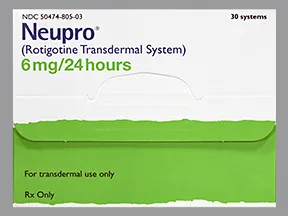 | |
| Neupro transdermal - | 4 mg/24 hour transdermal system | 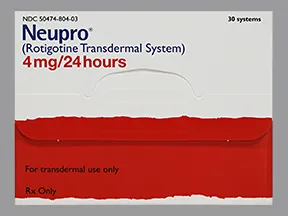 | |
| Neupro transdermal - | 8 mg/24 hour transdermal system | 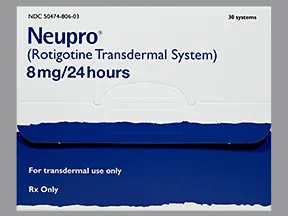 | |
| Neupro transdermal - | 2 mg/24 hour transdermal system |  | |
| Neupro transdermal - | 1 mg/24 hour transdermal system | 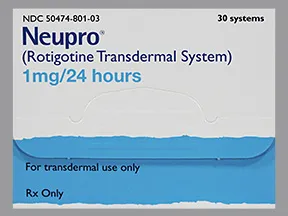 | |
| Neupro transdermal - | 3 mg/24 hour transdermal system | 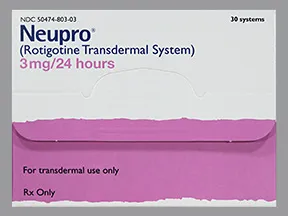 |
Copyright © 2010 First DataBank, Inc.
Patient Handout
rotigotine transdermal
ROTIGOTINE PATCH - TRANSDERMAL
(roe-TIG-oh-teen)
COMMON BRAND NAME(S): Neupro
USES: Rotigotine is used alone or with other medications to treat Parkinson's disease. It can improve your ability to move and decrease shakiness (tremor), stiffness, slowed movement, and unsteadiness. Rotigotine is also used to treat restless legs syndrome (RLS).Rotigotine is a dopamine agonist that works by helping to restore the balance of a certain natural substance (dopamine) in the brain.
HOW TO USE: Read the Patient Information Leaflet if available from your pharmacist before you start using rotigotine and each time you get a refill. Learn how to use this patch properly. If you have any questions, ask your doctor or pharmacist.Do not open the sealed pouch until ready to use. Do not cut the patch or use the patch if it appears broken, cut, or damaged. Open the pouch and remove the patch. Peel off the backing from the patch as directed and apply the patch to a clean, dry, and hairless area of the skin on the front of the abdomen, thigh, hip, side of the lower back (flank), shoulder, or upper arm. Press the patch firmly in place for about 30 seconds to make sure it stays on. Do not apply the patch on oily, broken, or irritated skin. Do not use creams, lotions, ointments, oils, or powders on skin where you are applying the patch. Avoid applying the patch to areas of the skin where it might be easily rubbed off (such as on skin folds or under tight clothing). If applying to a hairy area, shave the area at least 3 days before applying the patch. Wash your hands with soap and water after handling the patch. Do not touch your eyes or other objects until your hands are washed.The patch is usually worn for 1 day and replaced. Apply the patch to a different area on your body each time to avoid irritation. Wait at least 14 days before applying the patch to the same area. If the patch irritates the skin, protect the area from direct sunlight until the skin is completely healed. Sunlight may cause the irritated skin to change color.The dosage is based on your medical condition and response to treatment. To reduce your risk of side effects (such as nausea, dizziness), your doctor may direct you to start at a low dose and gradually increase your dose. Follow your doctor's instructions carefully.Use this medication regularly to get the most benefit from it. To help you remember, change your patch at the same time each day.To prevent the patch from coming off, use care while showering, bathing, and exercising. If the edges of the patch start to loosen, you may tape it in place with bandage tape. If the patch falls off, apply a new patch to a different area, and change the patch at your usual time the next day.When changing your patch, carefully remove the old patch, fold it in half with the sticky side together, and throw it away in the trash away from children and pets. Do not touch the sticky side with your fingers. Wash the application area with soap and water. Use baby oil or mineral oil to remove any leftover stickiness. Do not use solvents such as alcohol or nail polish remover. Always wash your hands after handling the patch, being careful not to touch your eyes or other objects until after you have washed your hands.Do not stop using this medication without consulting your doctor. Some conditions may become worse when this medication is suddenly stopped. Also, if you suddenly stop using this medication, you may have withdrawal symptoms (such as anxiety, depression, confusion, fever, muscle stiffness). To help prevent withdrawal, your doctor may lower your dose slowly. Withdrawal is more likely if you have used rotigotine for a long time or in high doses. Tell your doctor or pharmacist right away if you have withdrawal.Tell your doctor if your condition does not improve or if it worsens.
SIDE EFFECTS: Nausea, vomiting, loss of appetite, dizziness, drowsiness, lightheadedness, tiredness, trouble sleeping, increased sweating, headache, or redness/itching/swelling at the application site may occur. If any of these effects last or get worse, tell your doctor or pharmacist promptly.Remember that this medication has been prescribed because your doctor has judged that the benefit to you is greater than the risk of side effects. Many people using this medication do not have serious side effects.Tell your doctor right away if you have any serious side effects, including: mental/mood changes (such as confusion, agitation, hallucinations), severe dizziness, fainting, unusual strong urges (such as increased gambling, increased sexual urges), swelling ankles/feet, unusual weight gain, fast heartbeat, new or worsening uncontrolled movements.Some people using rotigotine have fallen asleep suddenly during their usual daily activities (such as talking on the phone, driving). In some cases, sleep occurred without any feelings of drowsiness beforehand. This sleep effect may occur anytime during treatment with rotigotine even if you have used this medication for a long time. If you experience increased sleepiness or fall asleep during the day, do not drive or take part in other possibly dangerous activities until you have discussed this effect with your doctor. Your risk of this sleep effect is increased by using alcohol or other medications that can make you drowsy. See also Precautions section.This medication may increase or decrease your blood pressure. You may develop a sudden drop in blood pressure that can cause dizziness, lightheadedness, nausea, sweating, and fainting. This is more likely when you first start the medication, when your dose is increased, or when you get up suddenly. To reduce your risk, get up slowly when rising from a sitting or lying position. Talk to your doctor if you need to check your blood pressure while using this medication.A very serious allergic reaction to this drug is rare. However, get medical help right away if you notice any symptoms of a serious allergic reaction, including: rash, itching/swelling (especially of the face/tongue/throat), severe dizziness, trouble breathing.This is not a complete list of possible side effects. If you notice other effects not listed above, contact your doctor or pharmacist.In the US -Call your doctor for medical advice about side effects. You may report side effects to FDA at 1-800-FDA-1088 or at www.fda.gov/medwatch.In Canada - Call your doctor for medical advice about side effects. You may report side effects to Health Canada at 1-866-234-2345.
PRECAUTIONS: Before using rotigotine, tell your doctor or pharmacist if you are allergic to it; or if you have any other allergies. This product may contain inactive ingredients (such as sulfites), which can cause allergic reactions or other problems. Talk to your pharmacist for more details.Before using this medication, tell your doctor or pharmacist your medical history, especially of: asthma, sleep disorders (such as sleep apnea, narcolepsy), low/high blood pressure, heart disease (such as heart failure), kidney disease, mental/mood disorders (such as schizophrenia).This drug may make you dizzy or drowsy. Alcohol or marijuana (cannabis) can make you more dizzy or drowsy. Do not drive, use machinery, or do anything that needs alertness until you can do it safely. Limit alcoholic beverages. Talk to your doctor if you are using marijuana (cannabis). See also Side Effects section.While wearing your patch, avoid exposing it to direct heat (such as heating pads, electric blankets, heat lamps, saunas, hot tubs, heated waterbeds, or prolonged direct sunlight). Heat may cause more drug to be released into your body, increasing the risk of side effects.Before having surgery, tell your doctor or dentist about all the products you use (including prescription drugs, nonprescription drugs, and herbal products).If you are going to have an MRI test or cardioversion, tell the health care provider that you are using this patch. Some patches may contain metals that can cause serious burns during an MRI or cardioversion. Ask your doctor whether you will need to remove your patch before the procedure and apply a new patch afterward, and how to do so properly.Older adults may be more sensitive to the side effects of this drug, especially mental/mood changes (such as hallucinations)During pregnancy, this medication should be used only when clearly needed. Discuss the risks and benefits with your doctor.It is unknown if this drug passes into breast milk. This drug may reduce the amount of breast milk you make. Consult your doctor before breastfeeding.
DRUG INTERACTIONS: Drug interactions may change how your medications work or increase your risk for serious side effects. This document does not contain all possible drug interactions. Keep a list of all the products you use (including prescription/nonprescription drugs and herbal products) and share it with your doctor and pharmacist. Do not start, stop, or change the dosage of any medicines without your doctor's approval.Tell your doctor or pharmacist if you are taking other products that cause drowsiness including alcohol, marijuana (cannabis), antihistamines (such as cetirizine, diphenhydramine), drugs for sleep or anxiety (such as alprazolam, diazepam, zolpidem), muscle relaxants, and opioid pain relievers (such as codeine).Check the labels on all your medicines (such as allergy or cough-and-cold products) because they may contain ingredients that cause drowsiness. Ask your pharmacist about using those products safely.
OVERDOSE: This medication patch may be harmful if chewed or swallowed. If someone has overdosed, remove the patch if possible. For serious symptoms such as passing out or trouble breathing, call 911. Otherwise, call a poison control center right away. US residents can call their local poison control center at 1-800-222-1222. Canada residents can call a provincial poison control center. Symptoms of overdose may include: mental/mood changes (such as confusion, hallucinations), uncontrolled movements, seizures.
NOTES: Do not share this medication with others.
MISSED DOSE: If you forget to change the patch, change it as soon as you remember. Do not double the dose to catch up. Then go back to your usual schedule for changing your patch.
STORAGE: Store the patches in their original pouch at room temperature. Do not open the pouch until you are ready to use the patch. Keep all medications away from children and pets.Do not flush medications down the toilet or pour them into a drain unless instructed to do so. Properly discard this product when it is expired or no longer needed. Consult your pharmacist or local waste disposal company. (See also How to Use section.)
Information last revised March 2024. Copyright(c) 2024 First Databank, Inc.
IMPORTANT: HOW TO USE THIS INFORMATION: This is a summary and does NOT have all possible information about this product. This information does not assure that this product is safe, effective, or appropriate for you. This information is not individual medical advice and does not substitute for the advice of your health care professional. Always ask your health care professional for complete information about this product and your specific health needs.
Formulary
Adding plans allows you to compare formulary status to other drugs in the same class.
To view formulary information first create a list of plans. Your list will be saved and can be edited at any time.
Adding plans allows you to:
- View the formulary and any restrictions for each plan.
- Manage and view all your plans together – even plans in different states.
- Compare formulary status to other drugs in the same class.
- Access your plan list on any device – mobile or desktop.




